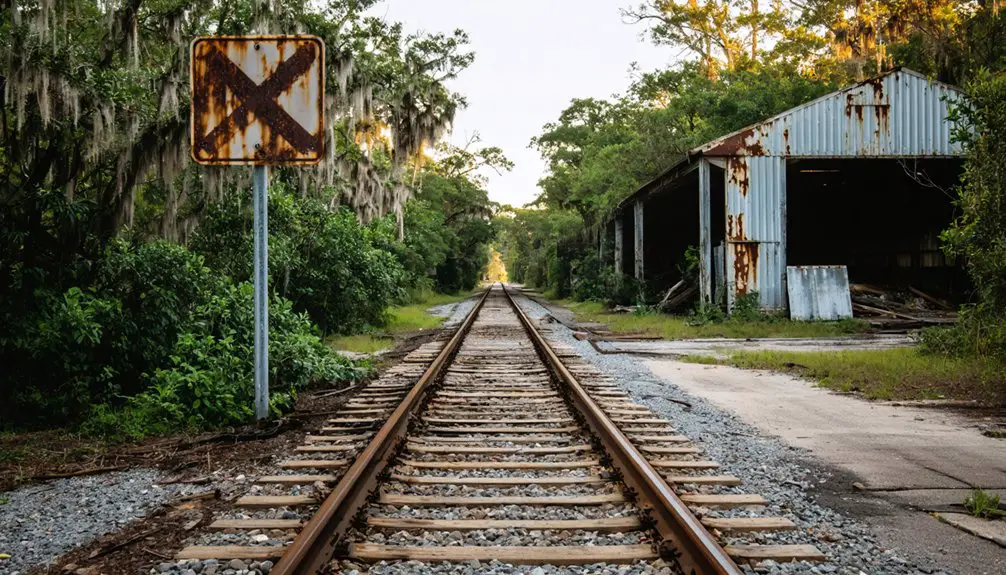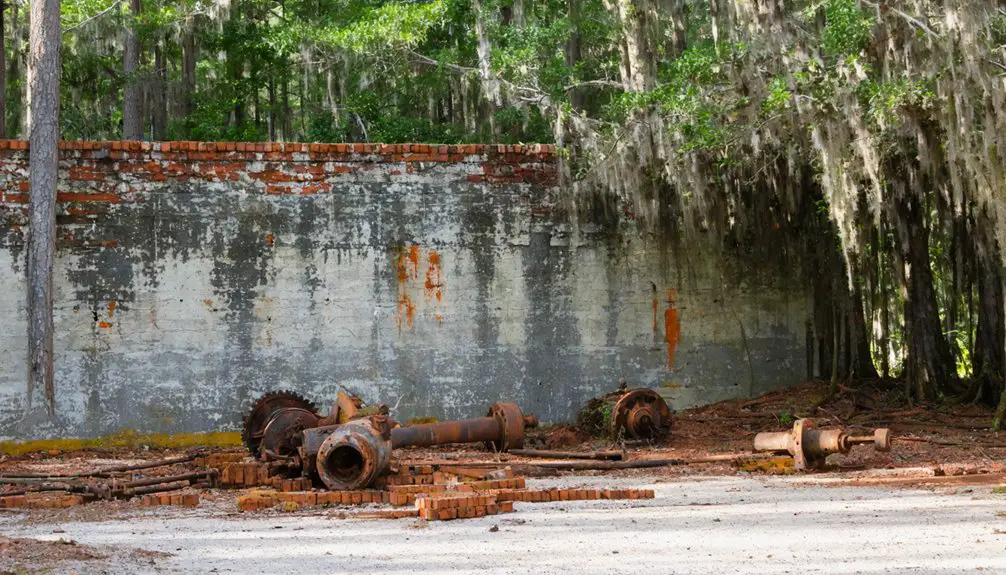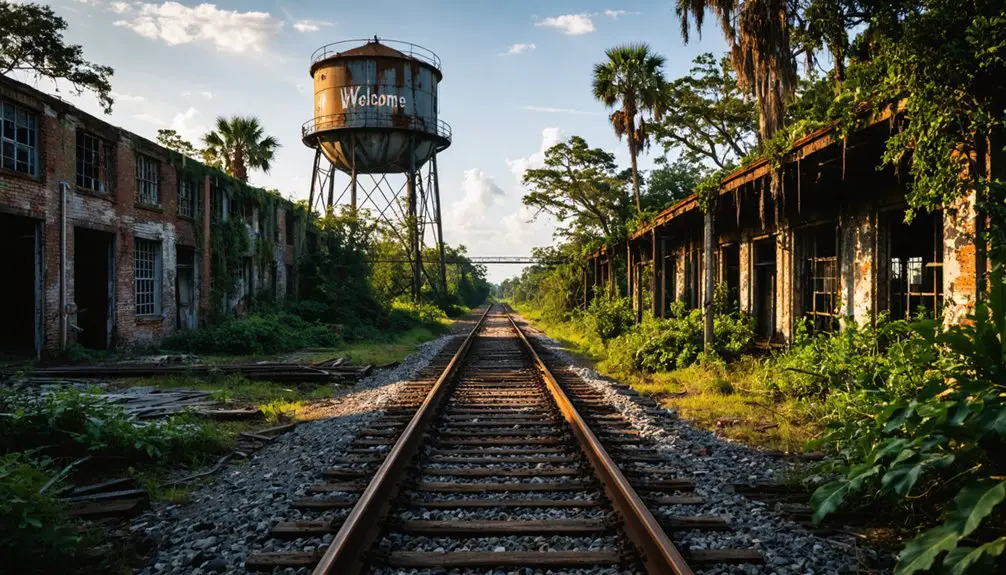You’ll find Welcome, Florida as a 5.5-acre ghost town that emerged during the late 19th century industrial boom. The town thrived through manufacturing, railroad connections, and lumber processing operations until several catastrophic events struck. Devastating freezes in 1894-95 destroyed the citrus industry, followed by the 1920s Florida real estate crash and Great Depression. Today, coastal vegetation reclaims the abandoned industrial sites, while fencing protects this fascinating piece of Florida’s industrial heritage.
Key Takeaways
- Welcome emerged as an industrial town during Florida’s late 19th century boom, centered around railroad operations and lumber processing.
- The town’s economic peak featured manufacturing facilities, including Martin Marietta, and strategic connections to urban markets.
- Severe freezes in 1894-95 destroyed local citrus industry, while the Great Depression and Florida real estate crash halted growth.
- New highway systems bypassed Welcome, cutting off vital transportation routes and accelerating its decline into a ghost town.
- The 5.5-acre abandoned site is now fenced off, reclaimed by coastal vegetation, and serves as habitat for local wildlife.
Origins and Industrial Foundations
While many Florida ghost towns emerged during the industrial boom of the late 19th century, Welcome’s story began as entrepreneurs sought to capitalize on the region’s abundant natural resources.
The town’s settlement patterns followed the typical industrial development model, with basic wooden structures and rudimentary roads appearing around key extraction points. Much like Ybor City’s cigar factories, the town developed manufacturing facilities that drove local economic growth.
You’ll find that Welcome’s early industrial foundations centered on regional resources, establishing processing facilities that attracted a diverse workforce.
Similar to Titusville’s growth, the area saw the establishment of commercial citrus shipping in the 1880s.
Labor dynamics shaped the community as young men, immigrants, and rural workers flocked to the area, seeking opportunities in the growing industrial operations.
The town quickly developed crucial infrastructure, including worker housing and transportation networks.
Rivers and wetlands nearby served dual purposes – providing both essential water supplies and efficient transport routes for the burgeoning industrial enterprises.
Economic Rise and Peak Years
As transportation networks expanded throughout Florida in the mid-20th century, Welcome experienced unprecedented economic growth driven by manufacturing and industrial development.
You’d have found a bustling landscape of economic resilience, where aerospace, electronics, and telecommunications firms established strong footholds in the region.
The town’s industrial innovation peaked when companies like Martin Marietta set up operations nearby, creating numerous job opportunities that attracted skilled workers.
Welcome’s strategic location near urban centers and its robust infrastructure made it an ideal hub for manufacturing.
You would’ve witnessed capital investment pouring into industrial facilities, while the broader tourism boom in Florida provided additional economic stimulus.
The town’s success during this period was marked by significant population growth, new housing developments, and strengthened trade connections with Latin American markets.
Glenn L. Martin Company’s arrival in 1955 sparked a massive employment surge in the region, drawing thousands of workers to the area.
The region’s economic transformation aligned with Florida’s shift toward light industry and service sectors that characterized the post-World War II era.
Industrial Operations and Infrastructure
In Welcome’s early days, you’d find a bustling railroad junction where freight cars delivered raw materials to the town’s manufacturing facilities and mills.
The town’s industrial backbone centered on large lumber processing operations that stretched across an area larger than a football field, with concrete foundations and heavy machinery designed for high-volume production. The Consolidated Naval Stores operated a major turpentine mill in the area before relocating in 1929. The abandoned phosphate processing plant later became a defining feature of the region’s industrial landscape.
Railroad connections proved essential to Welcome’s success, allowing finished products from its foundries and machine works to reach broader markets while supporting the town’s agricultural processing facilities.
Railroad and Manufacturing Hub
During the late 1800s, Welcome’s transformation into an industrial hub began with the strategic construction of railroad infrastructure that would shape the town’s destiny.
The railroad expansion brought crucial connectivity, linking Welcome to major ports and enabling efficient transportation of lumber and manufactured goods. Similar to the Strawn packing operation, Welcome’s industrial presence benefited greatly from railway growth in Florida during this era. The nearby Maddox Foundry established itself as a major manufacturing site in 1905. You’ll find that the town’s industrial footprint grew rapidly, with lumber mills and supporting factories strategically positioned alongside the rail lines.
Manufacturing facilities, including foundries and machine works, emerged to maintain the growing industrial operations. These factories produced necessary equipment parts and tools, creating a self-sustaining industrial ecosystem.
However, the town’s fortunes were closely tied to its railroad and manufacturing base. When industrial activity declined due to resource depletion and reduced rail service, Welcome’s once-bustling manufacturing hub gradually transformed into the ghost town you see today.
Processing Mills and Equipment
Welcome’s industrial legacy thrived through diverse milling operations that shaped Florida’s manufacturing landscape. You’d have witnessed early water-powered operations like those at Arcadia Mill Complex, where sawmills, grist mills, and textile factories operated alongside bucket manufacturing and blacksmith shops.
The site’s innovative sixteen-mile log flume showcased industrial ingenuity. Steam engines and circular saws significantly improved mill efficiency and production throughout north Florida in the 1840s.
As steam power emerged in the 1840s, the region’s industrial machinery evolved greatly. Mills gained mobility and efficiency through steam engines and circular saws, transforming small operations into mass-manufacturing hubs.
By the 1970s, steel production dominated the area when Florida Steel Corporation established its electric-furnace mill near Baldwin. The facility maintained its status as Florida’s only steel mill until 2020.
Today, you can explore remnants of this industrial evolution, from preserved sugar mill ruins with their limestone chimneys to modern steel recycling facilities processing thousands of cars annually.
Population Demographics Over Time
Like many frontier settlements of late nineteenth-century Florida, Welcome started with a modest population of pioneering families and workers drawn to its industrial potential.
The town’s demographic shifts reflected the broader patterns of Florida’s frontier development, with European settlers forming the majority alongside African American and immigrant laborers.
As Welcome grew, you’d have found:
- A mix of family units and single workers supporting the town’s industrial activities
- A population skewed toward working-age adults, particularly males
- A community that likely never exceeded 500 residents, similar to other small industrial settlements
The town’s population decline accelerated when economic opportunities dwindled, following the pattern of many Florida ghost towns.
Today, Welcome stands abandoned, with no permanent residents remaining in what was once a bustling industrial community.
Transportation Networks and Access

The railroad tracks that once served as Welcome’s lifeline tell a story of strategic transportation planning in frontier Florida.
Like many ghost towns, Welcome’s transportation evolution began with the Atlantic Coast Railroad Line, which connected the settlement to essential lumber mills and turpentine markets in the late 1800s.
Today, you’ll find these historic rail corridors reclaimed by cypress swamps and dense vegetation, creating access challenges for modern visitors.
While Florida’s current infrastructure focuses on expanding interstates and developing public transit near urban centers, Welcome’s remote location keeps it isolated from these improvements.
The abandoned rail beds and old spur roads that once bustled with industrial activity now serve as silent reminders of the town’s connected past, preserved within the natural landscape for historical education and environmental conservation.
Decline and Abandonment
When devastating freezes struck Central Florida in the winter of 1894-95, Welcome’s fate began its irreversible decline. The citrus industry’s collapse triggered a massive community exodus as residents lost their primary source of income.
The town’s economic decline accelerated through multiple waves of hardship:
- The Great Depression of the 1930s crushed remaining financial institutions and stalled any chance of recovery.
- Industrial mechanization eliminated skilled labor positions, forcing workers to seek opportunities elsewhere.
- The Florida real estate crash of the 1920s, worsened by the Prinz Valdemar disaster, halted development and dried up investment capital.
Later infrastructure projects, particularly new highway systems, bypassed Welcome entirely.
Without economic diversification and cut off from major transportation routes, the town couldn’t sustain its remaining population.
Present-Day Site Conditions

You’ll find the 5.5-acre ghost town largely reclaimed by Florida’s coastal vegetation, as years of abandonment have allowed natural growth to steadily encroach upon the deteriorating structures.
Since the 2023 acquisition, fencing and barriers block public entry to the site, though weathering from salt air and storms continues to reshape the landscape.
The property’s isolation has created an undisturbed environment where nature gradually overtakes the boarded-up apartment complex and former store, making documentation of the site’s evolution increasingly challenging.
Natural Area Reclamation
Over decades of abandonment, natural processes have steadily transformed Florida’s industrial ghost town sites into thriving ecological habitats.
Through ecological succession, native vegetation has reclaimed old industrial areas, with trees and shrubs breaking through concrete and vines covering deteriorating structures. Wildlife corridors have emerged as animals return to these peaceful spaces.
You’ll discover nature’s remarkable recovery at sites like these:
- Former logging railroads now hidden beneath thick forest canopy
- Old turpentine operations transformed into diverse woodland habitats
- Abandoned industrial zones converted to natural wetlands and floodplains
The soil’s healing process continues as organic matter accumulates, supporting increased biodiversity.
You can spot various birds, small mammals, and pollinators that now call these recovered spaces home, turning what was once industrial into a demonstration of nature’s resilience.
Site Access Challenges
Despite nature’s remarkable reclamation of the area, accessing this ghost town presents significant modern-day challenges. You’ll find the site heavily restricted since its 2023 acquisition by a private developer, with deteriorating buildings boarded up to prevent trespassing.
Hurricane Ian’s devastating impact in 2022 left structures unsafe and flood-damaged, while coastal weathering continues to compromise their stability.
You’re likely to encounter limited infrastructure, with underdeveloped roads and non-functioning utilities making navigation difficult. Safety concerns abound due to unauthorized occupants and vandalism, while legal battles over land use further complicate access.
The absence of proper lighting, signage, or secured entry points, combined with community opposition to visitors, means you’ll need to exercise extreme caution if attempting to explore this historically significant but increasingly hazardous location.
Historical Impact on Florida’s Development
Throughout Florida’s formative years, the interplay of pioneering settlements, industrial growth, and natural challenges shaped the state’s developmental trajectory. Early settlers brought diverse cultural influences, establishing communities that would face both prosperity and adversity. The transformation from agricultural outposts to industrial centers created lasting changes in Florida’s landscape.
Key developments that defined Florida’s growth:
- Railroad expansion connected isolated settlements, enabling trade between regions like Apalachicola and Port St. Joe.
- The rise of phosphate mining in Mulberry and lumber mills demonstrated the state’s industrial potential.
- Community resilience emerged through recurring natural disasters, leading to improved urban planning and water management.
These historical patterns continue to influence Florida’s development, from its transportation networks to its diverse cultural heritage, showing how past industrial ventures have left their mark on today’s communities.
Legacy and Heritage Preservation

While Florida’s ghost towns stand as silent witnesses to the past, their preservation has become increasingly crucial for understanding the state’s rich industrial heritage.
You’ll find these historic sites protected through legal restrictions on artifact removal and metal detecting, particularly in places like Centralia. Their cultural significance extends beyond physical remains, as they’re preserved through oral histories, archives, and digital documentation.
Community engagement plays a crucial role in maintaining these sites, with local groups contributing to preservation efforts and documentation.
You can explore these remnants of Florida’s industrial era through self-guided tours and ranger-led programs at locations like the Koreshan Unity colony.
Despite challenges from natural degradation and limited resources, these sites continue serving as educational platforms, offering you tangible connections to Florida’s economic and social evolution through heritage tourism.
Frequently Asked Questions
Were Any Notable Crimes or Mysterious Incidents Reported in Welcome?
You won’t find confirmed reports of crimes or unsolved mysteries in this location. While some Florida ghost towns have documented ghost sightings and dark histories, no notable incidents were specifically recorded here.
What Native American Tribes Inhabited the Welcome Area Before Industrial Development?
Like ancient spirits guarding sacred lands, you’d find the Timucua tribe primarily inhabited the Welcome area, with some evidence of Calusa influence extending into the region through trade and seasonal movements.
Did Welcome Have a School System or Educational Facilities?
You won’t find documented evidence of a school system or educational facilities in Welcome’s history. The industrial town’s short-lived nature and railway focus didn’t leave behind any known educational legacy.
What Natural Disasters or Environmental Events Impacted Welcome’s History?
Like a merciless giant, Hurricane Ian released devastating flooding events on your coastal community in 2022, submerging residential complexes and forcing you to abandon buildings that couldn’t withstand the hurricane impacts.
Were There Any Documented Cemetery Sites or Burial Grounds in Welcome?
You won’t find any definitively documented cemetery locations or burial grounds in Welcome. While nearby ghost towns like Alto and Coleman have preserved burial customs, Welcome’s cemetery sites remain unconfirmed by historical records.
References
- https://www.youtube.com/watch?v=0TLWOUfei-M
- https://www.youtube.com/watch?v=zgf6tE2mrCU
- https://www.youtube.com/watch?v=ZQf3AqatGD4
- https://abandonedin360.com/abandoned-commercial-properties/disston-sugar-mill-ruins/
- https://abandonedfl.com
- https://en.wikipedia.org/wiki/History_of_Ybor_City
- https://www.titusville.com/652/History-of-Titusville
- https://osceolahistory.org/history-of-kissimmee/
- https://www.orlando.gov/Our-Government/History
- https://www.visitflorida.com/travel-ideas/articles/st-augustine-welcome-to-americas-oldest-city/



